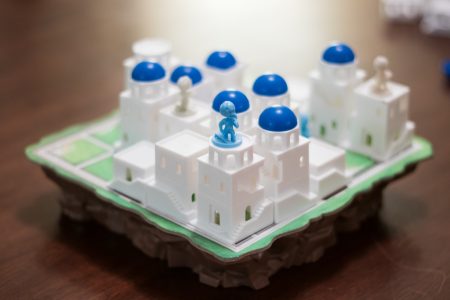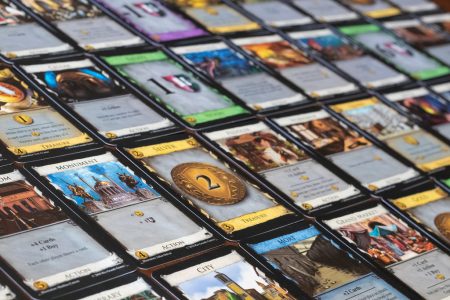Teaching Board Games #3: Scaffolding
This is the third in a series of posts on teaching board games, each illustrating how a research-based teaching principle can inform how one teaches a board game to new players. My goal in this series is to help readers understand these teaching principles by illustrating their use in a content domain outside the usual academic disciplines. Hopefully, you’ll get an idea or two for your own teaching, whatever you teach! And for readers who, like me, find themselves teaching a lot of board games, this series should be particularly fun.
In the first post, I shared some examples of taking advantage of players’ existing mental models when teaching new games. In the second post, I discussed ways to convey the big picture of a board game to help player’s organize their understanding of the game. Today, I’ll take a look at the notion of scaffolding in teaching board games.
 In the educational literature, scaffolding is used as a metaphor to describe how learners construct their knowledge over time. Consider how scaffolding is used in building construction: you place the first level, then stand on that first level to build the second level. Standing on the second level allows you to build the third level, and so on. Similarly, learners build new knowledge on existing knowledge.1 This happens at a variety of scales, from large (solving calculus problems requires a high proficiency with algebra) to small (problem 7 on the worksheet makes more sense if you understand problem 6). Just as it would be hard to build the top level of scaffolding without building the lower levels first, learning is harder when students have to take in too much information all at once, or when they have to develop more complex skills without first developing simpler, supportive skills. This leads to the teaching principle of scaffolding:
In the educational literature, scaffolding is used as a metaphor to describe how learners construct their knowledge over time. Consider how scaffolding is used in building construction: you place the first level, then stand on that first level to build the second level. Standing on the second level allows you to build the third level, and so on. Similarly, learners build new knowledge on existing knowledge.1 This happens at a variety of scales, from large (solving calculus problems requires a high proficiency with algebra) to small (problem 7 on the worksheet makes more sense if you understand problem 6). Just as it would be hard to build the top level of scaffolding without building the lower levels first, learning is harder when students have to take in too much information all at once, or when they have to develop more complex skills without first developing simpler, supportive skills. This leads to the teaching principle of scaffolding:
By providing students with learning experiences that build successively in complexity, we can help our students develop greater skills and knowledge.
Let’s consider how this principle plays out in teaching board games, then we’ll generalize to other teaching domains.
 In the game Santorini, players move around a 5×5 grid, building taller and taller buildings. Each turn, you select one of your two builders, move to an adjacent square (orthogonally or diagonally) and then build in an adjacent square (orthongonally or diagonally). You have to move, then build. If you can’t, maybe because both of your builders are blocked in, you lose. To win the game, you either block in your opponent or move one of your builders on top of a three-story building. That’s the base game. It’s light, quick, and rather abstract. But that’s not the whole game.
In the game Santorini, players move around a 5×5 grid, building taller and taller buildings. Each turn, you select one of your two builders, move to an adjacent square (orthogonally or diagonally) and then build in an adjacent square (orthongonally or diagonally). You have to move, then build. If you can’t, maybe because both of your builders are blocked in, you lose. To win the game, you either block in your opponent or move one of your builders on top of a three-story building. That’s the base game. It’s light, quick, and rather abstract. But that’s not the whole game.
Santorini comes with a stack of cards, each featuring a different Greek mythological figure. In the full game, each player selects one of these cards, giving that player a special ability within the game. Artemis lets you move twice before building, Hephaestus lets you build twice in the same space, and the Minotaur lets you knock opponents out of your way when moving. These card abilities add variability and fun to the base game, and are nicely thematic, in the sense that the powers match the stories of the mythological figures. However, the instructions recommend playing the base game a few times before adding in the cards, and they recommend playing with the simpler cards before playing the more complex cards, which can involve new win conditions or create interactions between player actions. With Santorini, the game designers provided intentional scaffolding for players, suggesting a sequence of game plays moving from simple to complex. This sequence has been useful in teaching the game to my kids, with the younger ones generally opting for the simpler card abilities, at least thus far.
 Lots of games use cards for scaffolding. For instance, take the 2018 release Everdell, which is probably the most adorable game I own. The basic rules are fairly straightforward: you send your workers to various locations on the board to gather resources, then spend those resources to add critters and constructions to your city, giving you new abilities and earning points. Three times during the game you’ll prepare for a new season (moving from winter to spring, for instance), which means calling your workers back so you can send them out again for new resources. After four seasons, the game is over and players add up the points in their cities to determine the winner.
Lots of games use cards for scaffolding. For instance, take the 2018 release Everdell, which is probably the most adorable game I own. The basic rules are fairly straightforward: you send your workers to various locations on the board to gather resources, then spend those resources to add critters and constructions to your city, giving you new abilities and earning points. Three times during the game you’ll prepare for a new season (moving from winter to spring, for instance), which means calling your workers back so you can send them out again for new resources. After four seasons, the game is over and players add up the points in their cities to determine the winner.
What makes the game complex is that each critter and construction you add to your city has a unique ability or scoring condition, specified on the critter or construction card. There are dozens of cards in the game (128 total, counting duplicates), making for a lot of different abilities and conditions to sort out. Since the cards don’t come out all at once, you don’t have to understand all the various card properties before playing. You can read the cards as they appear and try to figure out how they can help you build out your city. You’ll probably spend half your first game just reading and analyzing cards. That’s actually more fun than it may sound! This is another form of scaffolding. Everdell is a fairly complex game, but players can learn it in chunks as they become familiar with all the cards. As I mentioned, lots of games do this, from classics like Dominion and Twilight Struggle, to newer releases like Everdell and Tortuga 1667.
 Dominion was released by Rio Grande Games back in 2008. It was the first “deck-building” card game, with designer Donald Vaccarino inventing a new game mechanism that has gone on to appear in dozens of games. Each player starts the game with a small deck of standard-issue cards. On their turns, they draw five cards from this deck and use those cards to purchase new cards for their deck from a common supply. The five cards and the new cards go in the player’s discard pile. This process repeats until the player’s deck runs out, then they shuffle their discard pile and make that their new deck, and the game continues. This way, the cards the players purchase on their turns show up later in the game, as they are drawn from the player’s deck. The cards available for purchase include treasure cards, which are used to buy more cards; action cards, which have various effects; and victory cards, which provide end-game points. Play continues until a set number of victory cards have been purchased, then players count up the victory points they’ve bought for their decks. Most points wins.
Dominion was released by Rio Grande Games back in 2008. It was the first “deck-building” card game, with designer Donald Vaccarino inventing a new game mechanism that has gone on to appear in dozens of games. Each player starts the game with a small deck of standard-issue cards. On their turns, they draw five cards from this deck and use those cards to purchase new cards for their deck from a common supply. The five cards and the new cards go in the player’s discard pile. This process repeats until the player’s deck runs out, then they shuffle their discard pile and make that their new deck, and the game continues. This way, the cards the players purchase on their turns show up later in the game, as they are drawn from the player’s deck. The cards available for purchase include treasure cards, which are used to buy more cards; action cards, which have various effects; and victory cards, which provide end-game points. Play continues until a set number of victory cards have been purchased, then players count up the victory points they’ve bought for their decks. Most points wins.
I hope that explanation makes sense. I’ve found that the deck-building mechanism is hard to teach. It usually takes a few rounds of play, including one or two times shuffling the discard pile to replenish the deck, before players get the hang of it. That’s why I don’t try to teach a key bit of Dominion strategy up front: at some point during the game, you need to shift from buying treasure and action cards to buying victory cards. Early on, victory cards don’t help, because they fill up your hand with cards you can’t use. But by the end of the game, you need to purchase some high-value victory cards if you want to win. Thus, somewhere along the line, you have to shift your buying strategy. One fun part of the game is tracking your opponents, and attempting to make that shift just before they do. But in learning the game, that shift doesn’t make sense until you’ve played a little bit. That’s an example of scaffolding. I’ll explain the basic mechanics of the game when I teach it, but some of the strategy won’t make sense until a player has a good sense of those basic mechanics.
 So far, my examples of scaffolding in board games have all been within a single game, but there are a lot of ways scaffolding works across multiple games. For instance, if you’ve played Dominion, you’re more ready to play Clank!, another deck-building game that uses the same mechanics as Dominion, but adds a press-your-luck element by having players explore a dungeon and steal treasure from an increasingly angry dragon. Clank! is a more complex game (and, I think, a more exciting game) that builds on the mechanics in the simpler Dominion.
So far, my examples of scaffolding in board games have all been within a single game, but there are a lot of ways scaffolding works across multiple games. For instance, if you’ve played Dominion, you’re more ready to play Clank!, another deck-building game that uses the same mechanics as Dominion, but adds a press-your-luck element by having players explore a dungeon and steal treasure from an increasingly angry dragon. Clank! is a more complex game (and, I think, a more exciting game) that builds on the mechanics in the simpler Dominion.
There are lots of game sequences that work this way. Splendor, which I described in my last post, is often called an “engine builder,” since you buy cards that make it easier to buy better cards. That same mechanic appears in Gizmos, but the card effects are more complex, leading to some very entertaining chain reactions of cards triggering other cards. Everdell, mentioned above, is an engine builder, too, with even more complex card interactions than Gizmos. Everdell also uses a “worker placement” mechanic that can be introduced through simpler games like Stone Age. A game like Splendor is often called a gateway game, because it introduces mechanics that are used in other, more complex games, making it easier for new players to get interested in board games. If I want someone to play Everdell with me, I might introduce them to Splendor or Stone Age first, to get them ready for the more complex game.
There are other examples of scaffolding in board games, like alternate rule sets for games and games that release expansions for added complexity. But perhaps it’s time to generalize a bit, and talk about scaffolding in other teaching settings. What can we learn about sequencing learning activities for students from these examples?
- Chunk your content. You don’t have to explain everything up front for students. Give them enough background to start a reading or a problem, then let them discover additional layers and complexity as they go.
- Surprise your students. Sometimes, students aren’t ready to tackle a big idea or hard question at the start of a unit. Let them dig into the materials and see the idea or question for themselves, then help them make sense of it.
- Sequence for complexity. Consider the specific skills and understandings that students will need to tackle the hardest text or topic in your course, then select a sequence of texts or topics that will build in complexity to develop those skills and understandings.
More on teaching and board games in future posts. In the meantime, if you’d like a different take on teaching and board games, read Steven Johnson’s essay “The Game Worlds We Make.” He talks about the process of a designing a board game with his nine-year-old, and all the learning that happened through that process. Just last night, my 11-year-old and I prototyped a game I’ve been designing in my head for a few weeks, and it was great to see her get so engaged in thinking through the mechanics of the game and the emergent behavior they produced as we played.
1. This isn’t the only way the metaphor of scaffolding is used in educational literature. Vygotsky and Bruner refer to scaffolding as supporting structures that teachers provide to students as they’re learning, structures that the teachers will eventually remove as students gain knowledge and understanding… just like scaffolding is removed from a building once it can stand on its own. Vygotsky’s notion of scaffolding is necessarily social, since he recommends that those supporting structures consist of help from teachers and fellow learners. This is a good metaphor, but not one I usually use in my work with college faculty. The Vygotsky / Bruner metaphor is more local, focusing on what students need to move into their zone of proximal development, where the scaffolding metaphor I use is more global, considering the sequence of learning activities over time. See this Twitter thread for more on the two metaphors.